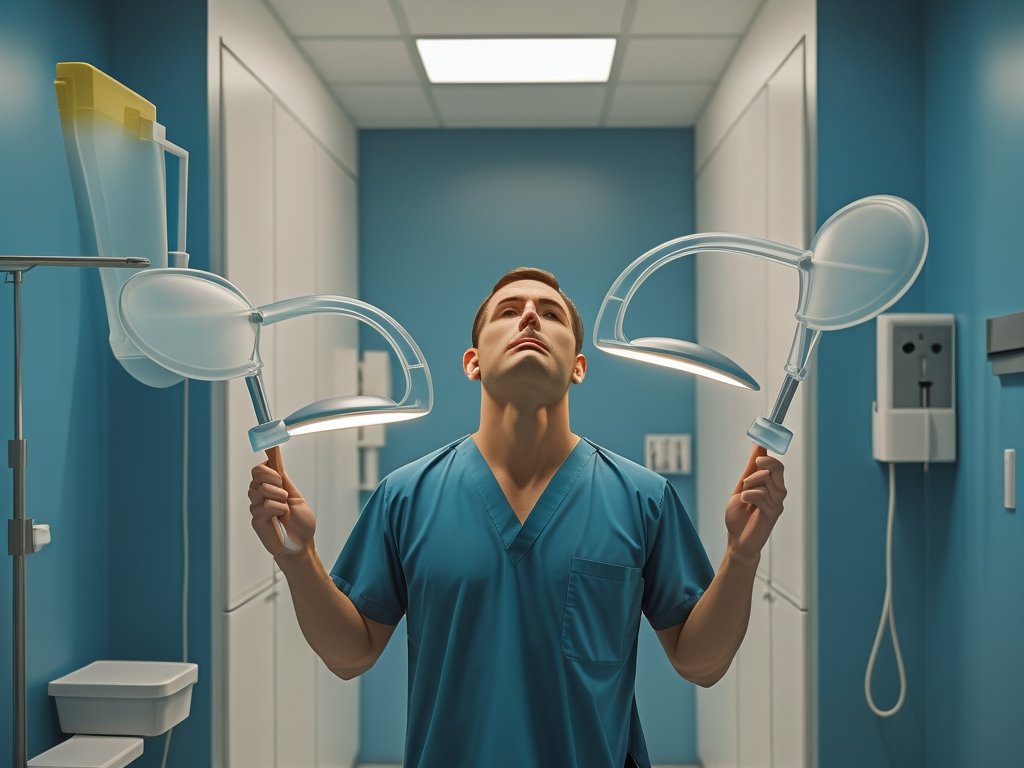Urinary retention, the inability to completely empty the bladder, can be a frustrating and even debilitating condition for men. It’s not simply about difficulty starting urination; it encompasses issues with flow rate, incomplete emptying, and persistent discomfort. Often stemming from an enlarged prostate (BPH), neurological conditions, or obstructions, urinary retention impacts quality of life significantly, leading to anxiety, sleep disturbances, and increased risk of complications like urinary tract infections. Understanding the nuances of how posture and body positioning can influence urination is a surprisingly powerful tool for managing these symptoms, offering men practical strategies to regain some control over their bodily functions and improve their overall well-being. This article will delve into specific angles and techniques that may aid in more complete bladder emptying.
Many factors contribute to successful urination beyond just the physical act itself. Relaxation plays a crucial role; tension in the pelvic floor muscles can actively impede flow. Similarly, gravity’s effect isn’t always optimized by conventional standing positions. Men experiencing retention often find themselves straining, which paradoxically worsens the problem. The goal is to minimize strain and maximize gravitational assistance while simultaneously relaxing surrounding musculature. This requires a degree of experimentation—what works best varies from individual to individual—but there are established principles and techniques that serve as excellent starting points for exploration. It’s important to remember that these strategies aren’t cures, but rather tools to help manage symptoms alongside any medical treatment prescribed by a healthcare professional. If you have concerns about underlying causes, consider exploring resources on BPH symptoms and diet.
Optimizing Body Positioning for Voiding
The standard standing position isn’t necessarily the most effective for men with retention. While convenient, it doesn’t always leverage gravity optimally or encourage relaxation of the pelvic floor muscles. Often, leaning forward slightly can help. This slight shift in weight distribution encourages a more natural flow and reduces the strain on the bladder. Think about how posture impacts other bodily functions – sitting upright aids digestion, for example. The same principle applies here: a conscious adjustment to body positioning can significantly influence urinary function. Many men report success with a mild forward lean while seated, effectively using gravity to assist emptying.
Beyond leaning, consider the angle of your legs. Spreading them slightly wider than shoulder-width apart can also be beneficial. This subtle change relaxes the perineum – the area between the scrotum and anus – which contains muscles that contribute to urinary control. A constricted perineum can impede flow, while a relaxed one allows for easier passage of urine. Experimenting with slight variations in leg positioning is key; what feels most comfortable and effective will be unique to each individual. It’s crucial to avoid forceful spreading or straining, as this defeats the purpose – the aim is gentle relaxation, not exertion.
Finally, seated urination can often be more effective than standing for those with retention issues. This isn’t just about comfort; it provides a stable base and allows for greater control over pelvic muscle relaxation. The act of sitting inherently reduces the effort required to maintain balance, freeing up resources for the bladder’s emptying process. Consider using a stool under your feet while seated to further enhance the angle and support. Again, this is about finding what feels right; some individuals may find that elevating their knees slightly improves flow, while others might prefer a more grounded position. To complement these practices, explore relaxation rituals for discomfort to further ease the process.
The Role of Pelvic Floor Relaxation
The pelvic floor muscles are intimately connected to urinary function. These muscles support the bladder, urethra, and rectum, and play a critical role in continence. However, when these muscles become tense or constricted, they can impede urine flow and exacerbate retention symptoms. Chronic tension is common, often stemming from stress, anxiety, or even habitual clenching. Learning techniques to relax these muscles is therefore vital for managing urinary retention.
One effective technique is diaphragmatic breathing – also known as belly breathing. This involves consciously expanding the abdomen while inhaling and allowing it to naturally contract during exhalation. This type of breathing promotes relaxation throughout the body, including the pelvic floor. Practicing this regularly can help reduce overall tension and improve bladder function. Another approach is progressive muscle relaxation, where you systematically tense and then release different muscle groups, starting with your toes and working your way up to your head.
It’s important to distinguish between strengthening and relaxing the pelvic floor. While strengthening exercises (like Kegels) can be helpful for incontinence, they’re often counterproductive in cases of retention if the muscles are already tight. In these instances, focusing on relaxation techniques is paramount. If you’re unsure whether strengthening or relaxation is appropriate for your situation, consult with a physical therapist specializing in pelvic floor health. Consider also reviewing breathing techniques for flow management to further support relaxation.
Utilizing Gravity and Body Weight
As mentioned earlier, gravity plays a significant role in aiding urination. By strategically positioning the body, men can harness gravitational force to facilitate more complete bladder emptying. Leaning forward while seated (or even standing) creates a natural downward slope that encourages urine flow. This is particularly helpful for those with weakened bladder muscles or obstructions within the urinary tract. Think of it like tilting a glass – gravity assists in pouring out the liquid.
Body weight distribution also matters. Shifting your weight slightly forward can further enhance gravitational assistance and reduce strain on the pelvic floor. Avoid rigidly holding yourself upright; instead, allow your body to be supported by the chair or surface you’re leaning against. This reduces unnecessary tension and allows for a more relaxed voiding process. Experiment with different angles and degrees of lean to find what feels most comfortable and effective.
The key is to avoid resistance. Don’t actively try to push urine out; instead, allow gravity to do the work. Relax your abdominal muscles and focus on breathing deeply. This approach minimizes strain and maximizes the chances of complete bladder emptying. Remember that consistency is key – practicing these techniques regularly can help improve urinary function over time. Staying hydrated supports this process—learn more about smart hydration strategies.
The Importance of Hydration and Timing
While body positioning focuses on the mechanics of urination, other lifestyle factors significantly influence bladder health. Adequate hydration is paramount, despite seeming counterintuitive when dealing with retention. Dehydration concentrates urine, making it more difficult to pass and potentially irritating the bladder lining. Aim for a consistent intake of water throughout the day – typically around 8 glasses (64 ounces) – unless your doctor advises otherwise due to other medical conditions.
Timing your fluid intake strategically can also be helpful. Avoid drinking large amounts of fluids right before bedtime, as this can lead to nighttime awakenings and increased urgency. Instead, spread your fluid consumption evenly throughout the day. Also, avoid caffeine and alcohol, as these substances can act as diuretics, increasing urine production and potentially exacerbating retention symptoms.
Finally, don’t ignore the urge to urinate. Holding it in for prolonged periods can stretch the bladder and weaken its muscles over time. When you feel the urge, find a comfortable and private place to void without rushing or straining. Remember that these lifestyle adjustments complement body positioning techniques and contribute to overall bladder health. Consider also how meal patterns impact flow, especially as you age.
Disclaimer: This article provides general information on urinary retention and potential strategies for managing symptoms. It is not intended as medical advice and should not be substituted for professional healthcare. If you are experiencing urinary retention, it’s crucial to consult with a qualified physician or urologist for proper diagnosis and treatment. Self-treating can be dangerous and may delay appropriate care.





















